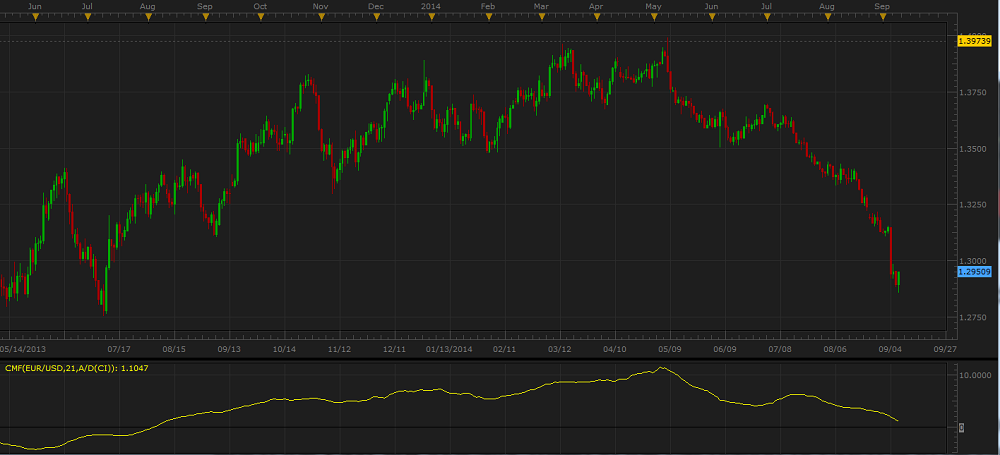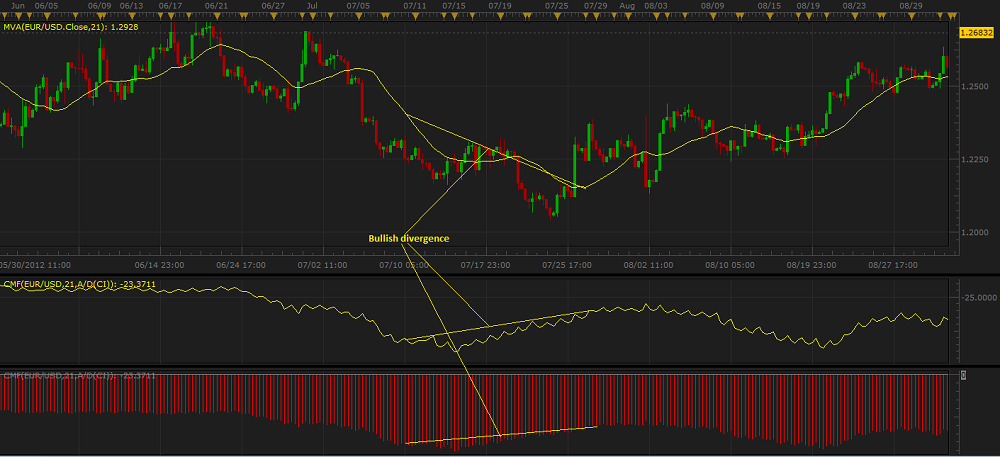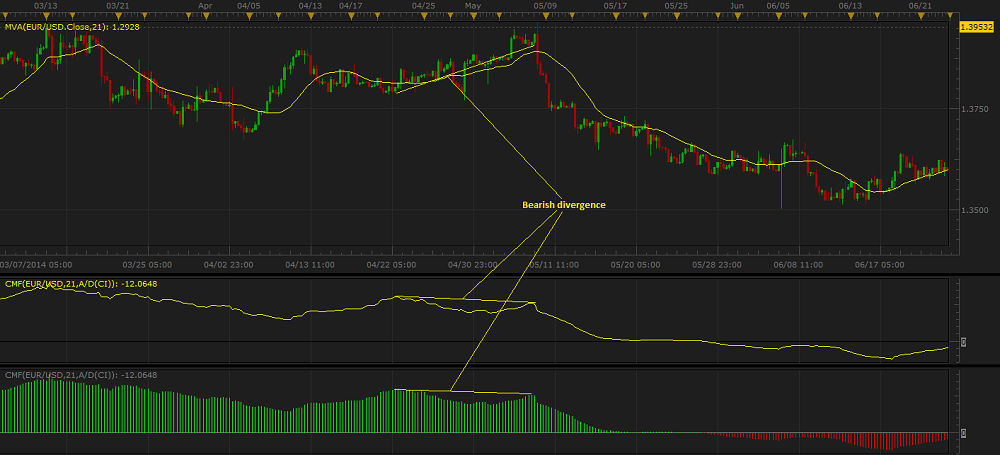
CMF (Chaikin Money Flow)
CMF (Chaikin Money Flow) is a volume oscillator that was developed by Mark Chaikin in 1970's. Besides CMF, Chaikin developed AD (Accumulation/Distribution) and CHO (Chaikin Oscillator) oscillators that are listed among the standard indicators of Marketscope.
CMF is intended to be an auxiliary indicator confirming or declining the trading signals of other technical analysis tools it is used in conjunction with. Together, the oscillator and tools, help to determine the market price trend's direction, strength, and reversal points.
For this purpose, CMF measures the volume of ticks (an instrument's price changes that happen every time when a certain number of trades take place on the market) flowing into (accumulation) and out (distribution) of an instrument during a specified time period. The oscillator's values are obtained by, first, calculating the sum of the AD oscillator's values of a specified number of periods, then, calculating the sum of the oscillator's tick volume values of the same number of periods, and, finally, dividing the sum of the AD oscillator's values by the sum of the oscillator's tick volume values. (The mathematical formulas are provided later in the article). A running total of the CMF values forms a line (or a histogram as a trader's choice can be). The line fluctuates above and below the zero line. When the CMF line is above the zero line, the buying (accumulation) tendency prevails over the selling (distribution) one. As a result, the market prices go up forming an uptrend. On the contrary, when the CMF line is below the zero line, the selling (distribution) tendency prevails over the buying (accumulation) one, the market prices go down forming a downtrend. The further away from the zero line the oscillator's values are, the stronger the respective tendency is.
As a rule, the direction of the oscillator's line coincides with the direction of the market price trend, but sometimes the oscillator's line diverges from the market price trend's direction, thus, forewarning of possible trend reversals.
Please note that CMF is always drawn in an additional area below the market price chart.
On the following picture you can see an example of the CMF oscillator drawn as a line in an additional area below the market price chart.

CMF inherits the drawbacks of the AD oscillator, the data of which it uses in its calculations. It can overlook such important events as minor changes and gaps (when the bars of two consecutive periods do not overlap each other) of the market prices. For more information, see the AD (Accumulation/Distribution) article.
Please remember that, for its calculation, the oscillator uses the historical data, and all the information it provides belongs to the past. A trader can only suppose that the past tendencies will continue to develop in the same way for some time in the future and try to use them appropriately.
To apply a CMF oscillator to a chart, a trader needs to follow the procedure common to all Marketscope indicators. For more information, see theAdd Indicator article.
During the procedure, a trader can customize an oscillator by specifying its parameters in the Properties dialog box. For more information, see the Change Indicator Properties
article.
The parameters fall into two groups:
In addition to the traditional Line color, Line width, and Line style parameters, the Style list includes three more entries:
On the following picture, you can see examples of the CHO oscillator drawn as a line and histogram.

The parameters are available on the Parameters tab of the CMF Properties dialog box under the Style heading.
CMF has two Calculation parameters:
The parameters are available on the Parameters tab of the CMF Properties dialog box under the Calculation heading.
When a CMF oscillator is drawn on a chart, a trader can analyze its information and try to interpret it correctly. CMF can be used to confirm or decline two major trading signals:


The CMF oscillator's values are calculated automatically using the following formulas:
CMF = Sum of AD / Sum of TV
Sum of AD = ADi + ADi-1 + ... + ADi-N+1
Sum of Tick volume = TVi + TVi-1 + ... + TVi-N+1
where:
CMF - is the CMF value of the period being calculated.
Sum of MA - is the sum of the AD oscillator's values of N periods.
Sum of TV - is the sum of the Tick Volume values of N periods.
ADi - is the AD oscillator's value of the period being calculated.
TVi - is the Tick Volume value of the period being calculated.
N - is the number of periods, over which the CMF oscillator is to be calculated.